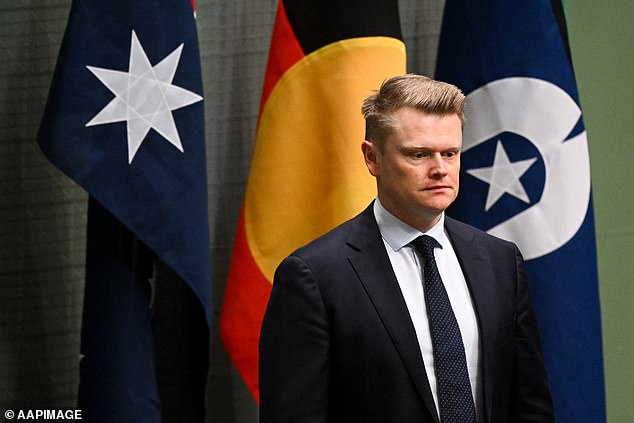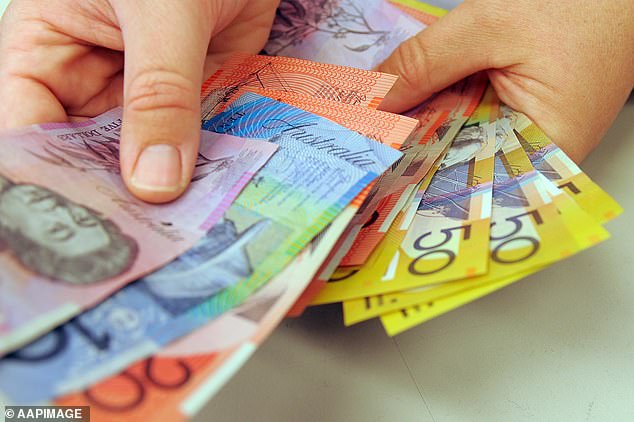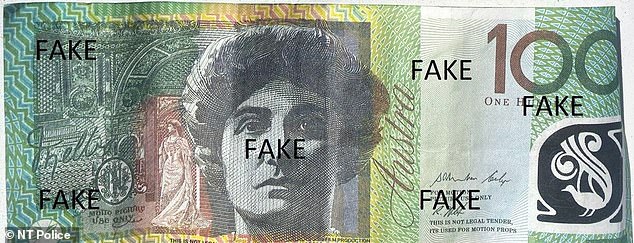MP Keith Wolahan’s dark warning of the consequences of a cashless society as hundreds of bank branches close across Australia: ‘They could switch off your banking just like that’
A federal MP has issued a dark warning that Australia will move away from cash as hundreds of bank branches closed in just a year.
Keith Wolahan, the Liberal member for Menzies in Melbourne’s north-east, has warned of a totalitarian society in which banks could ultimately cut off Australians’ ability to spend money entirely – because fewer people use cash.
“For the convenience of the bank, just to know what your ID was, even if you had been with them for decades, they could easily switch off your banking affairs,” he told the House of Representatives on Wednesday.
“They can disconnect you from your ability to be part of the economy.”
Fewer than one in six personal transactions are now done in cash.
Mr Wolahan, a first-term backbencher, said the minority of Australians who were still using banknotes needed to be listened to, especially when it came to privacy.
“After Covid, very few people are carrying cash,” he said.
‘There is even an attempt to get rid of cash. We make people vulnerable to that.
“So you can understand the distrust that people have about the way their digital identification is being used and the suspicion they have about how vulnerable they are in the digital economy.”

Keith Wolahan, the Liberal member for Menzies in Melbourne’s north-east, has warned of a totalitarian society in which banks could ultimately cut off Australians’ ability to spend money entirely – with fewer people using cash.
Mr Wolahan, a former army commando and lawyer, revealed that his own bank cut him off when he was in a cafe before the school drop-out and had to call his brother to take his children to school.
‘I went to pay and my card didn’t work and I thought that was strange. “I did another one, but it didn’t work,” he said.
‘I looked at my online banking and they were all way over the limit, I didn’t understand why but I knew I had to take them to school – I then called the bank and realized there would be a long wait so I had to to send for my brother and take my children to school quickly.
“When I finally got to the bank, I found out that they wanted to talk to me about verifying my driver’s license and to get my attention, they stopped all my banking.
‘They did that at a time when many people were leaving the parking garage and could not pay and there was a huge queue behind them; many people, like me, felt embarrassed in front of their friends and family at restaurants; a lot of people had things to do.”
This is happening now that banks are reducing the number of branches and removing ATMs.
In the year to June, 424 bank branches closed their doors, the Australian Prudential Regulation Authority announced on Wednesday.
The number of branches has fallen by more than a third or 37 percent since June 2017.
The banking regulator’s figures also showed the mass demolition of ATMs, with numbers falling by 60 percent in just six years.
Last year alone, 718 ATMs were removed.
Australia’s major banks have also halved the number of bank branches in very remote areas where more Aboriginal people live, despite being major donors to the Yes campaign.
The APRA data was released four days after the Voice referendum proposal was defeated, with the no vote receiving 60.8 percent support.
The Big Four banks have collectively donated $7 million to the Indigenous Voice to Parliament campaign.
But in just five years the number of branches in ‘very remote Australia’ has almost halved from 72 to just 40.
The numbers in remote areas, far from a regional center, fell from 145 to 98 between June 2018 and June 2023.
According to the 2021 Census, Aboriginal and Torres Strait Islander people make up almost a third or 31.9 percent of residents in very remote areas of New South Wales.
Mr Wolahan slammed the banks for supporting the Yes cause while shortening bank branches in areas where more Indigenous Australians lived.
‘The core of this is trust. “I don’t want to call the referendum again, but those same banks donated millions of dollars to one side of a campaign that was out of step with the very people they were keeping from being able to pay for things,” he said.
“Perhaps those millions would have been better served (a) by paying directly for Indigenous disadvantage and (b) having people on the phone so that people who were beaten in restaurants and stores, had their bills cut off, and who were incarcerated parking lots were not waiting for such an emergency call.
“There is a disconnect between the priorities of some of Australia’s business community and the realities Australians face.
“We saw that this weekend and I hope they think about that.”

In the year to June, 424 bank branches closed as 718 ATMs (Brisbane bank, pictured) were removed, the Australian Prudential Regulation Authority revealed
A spokeswoman for the Australian Banking Association told Daily Mail Australia there are 85 free ATMs in the most remote parts of the country and 3,540 Australia Post stores doing banking.
“Banks have a range of practical ways in which they support First Nations Australians to access banking services in regional and remote areas,” she said.
The dwindling number of Australians who still use cash are much more likely to have a counterfeit banknote if it is an old polymer note from the 1990s.
The Reserve Bank of Australia’s 2023 annual report found that the $100 banknotes that first entered circulation in 1996 were the most likely to be counterfeit.
During the past fiscal year, 6,171 first-generation $100 polymer banknotes were found to be counterfeit.
They made up 99.7 percent of the 6,187 $100 counterfeit Australian banknotes in circulation, of which only 11 were new generation banknotes, with a top-to-bottom window, released in 2020.
Only five counterfeit $100 notes were of the old paper money type first issued in 1984.
“The number of counterfeits is highest for the $100 denominations, especially for the older series,” the RBA report said.
“There have been very few NGB counterfeits in circulation to date.”
Counterfeit $100 notes also made up 62 percent of the 9,970 counterfeit notes seized.
The first generation of polymer $50 notes, first issued in 1995, were the second most likely to be counterfeit: there were 3,664 in circulation, accounting for 98.8 percent of the 3,707 counterfeit yellow notes.
The remainder consisted of 43 new-generation $50 notes issued in 2018.
Only a handful of counterfeit notes were in $5, $10 and $20.
Of the counterfeit $20 bills, 56 were first-generation polymer money, originally released in 1994, while the other four were a new-generation bill first issued in 2019.

The dwindling number of Australians who still use cash are much more likely to have a counterfeit banknote if it is an old polymer note from the 1990s

The Reserve Bank of Australia’s 2023 annual report found that $100 notes first put into circulation in 1996 were most likely to be fake
There were no counterfeit paper $20 bills in circulation that were first issued in 1966.
Only ten counterfeit $10 banknotes were intercepted, nine of which were a first-generation polymer note, first issued in 1993, and the other a new-generation banknote, first issued in 2017.
The $5 banknote was the only one on which the most counterfeits were of a new-generation note and not of the first-generation polymer note with the late Queen on it.
Of these counterfeits, five were of a new generation banknote released in 2016, while only one from the series was first issued in 1992.
Just 16 per cent of in-person transactions in 2022 were made in cash, a halving from 2019 when the pandemic saw a rise in tap-and-go payments, Reserve Bank data showed.
